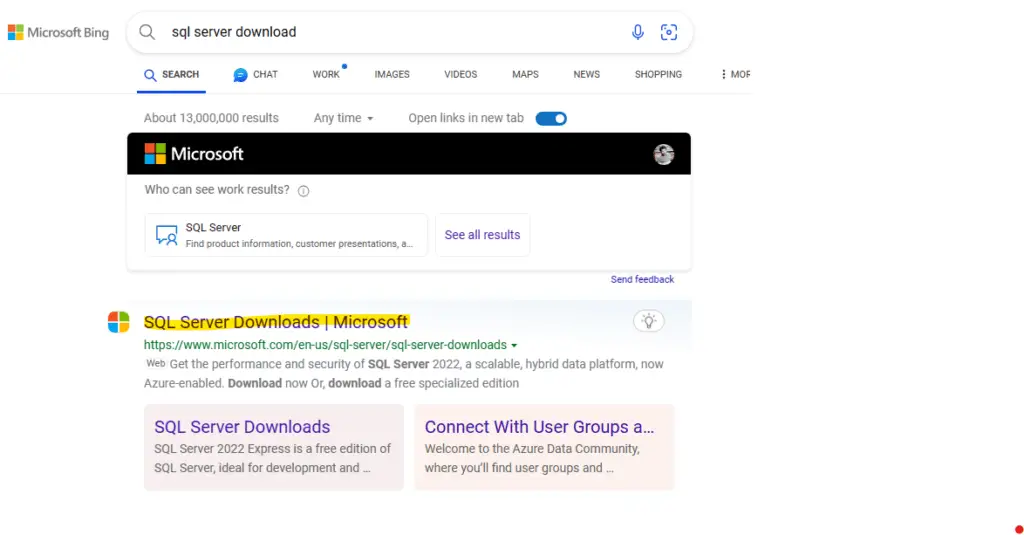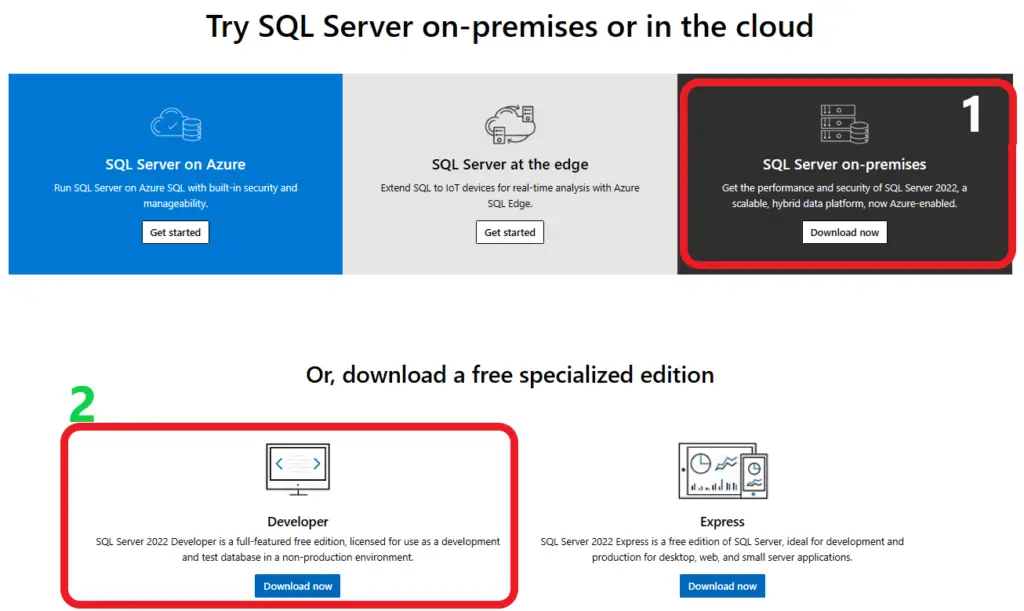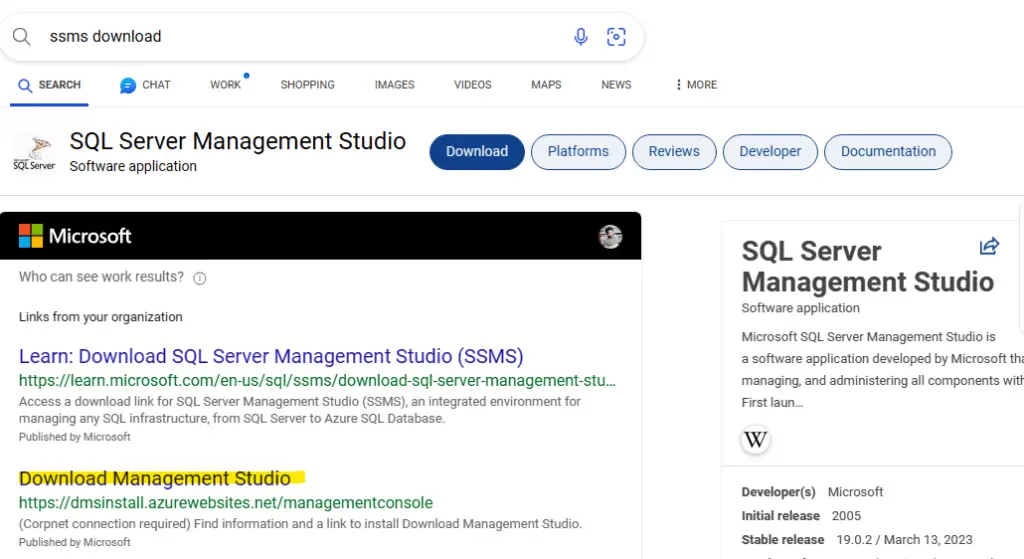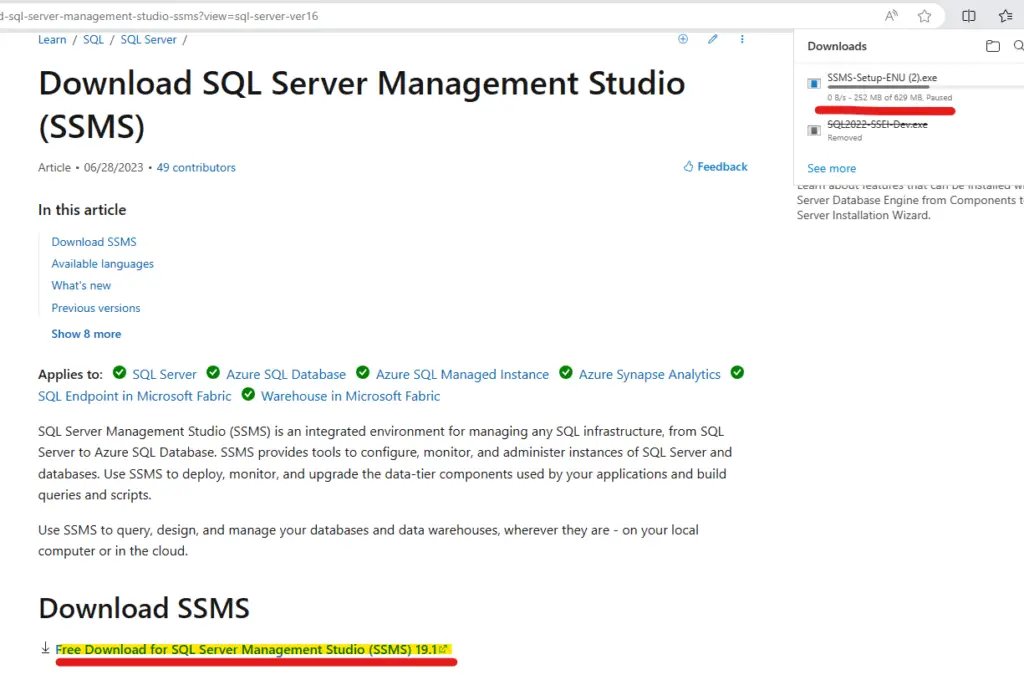Install SQL Server on Windows: In this below article how to create SQL Failover Cluster Instance, if you see in the above image, you can see 3 Machines (SQLA, SQLB & SQLABFCI) and in this 3 VM’s we will configure our SQL Cluster.
There are 2 different ways to create SQL cluster, one is for default instance and other one is named instance, the process follows below, and you can follow any one from the 2 option whether you have named or default instance:
- SQLA we will install default instance cluster and make SQLABFCI as failover cluster
- SQLB we will install named instance cluster and make SQLABFCI as failover cluster
The next 2 articles after this article will guide you how to add named or default instance to SQL Cluster but this article will be same if you are installing new failover node, either for named or default instance.
#1) SQL Server Download?
Step 1: Go to your browser and types “SQL Server Download” and you can click the below Microsoft link.

Step 2: Here we can see 2 methods to download the SQL Server 2022, you can select any 1 option and proceed further. I will suggest to go with “Developer” option which is option 2. Link: https://www.microsoft.com/en-us/sql-server/sql-server-downloads

Step 3: Once you download the file it will be saved into your PC, just open it and follow the below steps:
#2) SQL Server ISO file download?
Step 1: If I open the setup file then you can see this below interface. For more control you can download the Media (ISO File), in my case I will go with 3rd option.

Step 2: By default, the ISO will be selected and folder path as well, just change the download folder if you want and click on download below.

Step 3: The file has started to download, now wait until the setup file is completed. Once downloaded move to below steps.

#3) SQL Server Installation?
Step 1: Open the ISO file which you have downloaded in the above step, and you can see the setup file just open it.

Step 2: Click on New SQL Server Failover Cluster Installation.

Step 3: Now go to “Installation” menu and click on the first option mentioned in the below image.

Step 4: Give primary node SQL instance name and follow the steps below as shown below. In my case I already have one SQL instance, but it will be empty for you!

Step 5: It will check the basic details, just hit next to go to next step.

Step 6: It will give you list of options to select the disk, in my case I have only 3 disk which we created earlier for our SQL server.

Step 7: Specify the SQL cluster IP, make sure it should be on same network, we can guess by seeing the existing subnets.

Step 8: Specify the SQL Agent and SQL Server Service account which we created earlier, if not please go back and create one form the link here!

Step 9: Add the account which we created earlier, the SQL Agent and SQL Server Service account.

Step 10: Now click on Data Directories and use the following file paths of drives to specify the locations. Please check this doc if you have not created one.
We will use this drive path later to install our SQL server:
- Data Disk: C:\ClusterStorage\Volume1\MSSQL\Data
- Log Disk: C:\ClusterStorage\Volume2\MSSQL\Log
- Temp Disk: C:\ClusterStorage\Volume3\MSSQL\Temp

Specify the directory path as shown in the above image and also specify the path correctly, in this above image we have just changed Data and Logs path and temp is done in next step.
Step 11: Now we have to configure the temp db., if you are not familiar then please check this doc: tempdb database – SQL Server | Microsoft Learn Once done, come back and configure as per your requirements.
Note: According to Microsoft documentation, “The number of secondary data files depends on the number of (logical) processors on the machine. Generally, if the number of logical processors is eight or fewer, use the same number of data files as logical processors. If the number of logical processors exceeds eight, use eight data files. If contention persists, increase the number of data files by multiples of four until the contention decreases to acceptable levels, or modify the workload/code.” This information is available below: tempdb database – SQL Server | Microsoft Learn
Then comes the Temp DB size, for that please check this doc: https://www.brentozar.com/archive/2016/01/cheat-sheet-how-to-configure-tempdb-for-microsoft-sql-server/
Also I have changed the Temp DB location to our shared drives which we created earlier.

Step 12: We have to specify the MaxDOP as per this document: https://www.mssqltips.com/sqlservertip/6211/sql-server-2019-installation-enhancements-for-maxdop-and-max-memory/. In my case my logical processor is of 2 so it by default selected.

Step 13: I have given half of my VM memory, we should not include all your VM memory to SQL Server, so depending on requirements we have to specify the memory, for more click here!

Step 14: You can leave this as default as we are not using most of the time but if you want to learn more about, please click this doc: FILESTREAM (SQL Server) – SQL Server | Microsoft Learn

Step 15: The installation is complete, now we can connect and check the SQL Server Instance.


#4) Connect SQL In SSMS?
Step 1: Go to your browser and type SSMS download and open the first link of Microsoft.

Step 2: Click on the below link and your SSMS will start downloading as you can see in the below image.

Step 3: Open the setup file then install the SSMS and open it and go to the home page after installation.

Step 4: In the homepage you can see “Connect” option at the top, just click on that and select SQL Database.

Step 5: Give the instance name followed by your Machine name. (PC is my VM name and PCDB is the SQL Server which we created in the above steps). Click on “Connect”

Step 6: We have successfully created the SQL Server and connected using SSMS as you can see in the below step.

Next: Add SQL Server To SQL Server Failover Cluster (SQLFCI-12)
Watch!
TSG’s
- The Job Failed. Unable To Determine If The Owner (KTTsvc_ssrs19) Of Job
- Port Number For Analysis Services – Find Ports For SSAS? (kingfishertechtips.in)
- SMTP Server In SSRS/PBIRS |Subscribe To Email Problem/Issue (kingfishertechtips.in)
- SQL Server 2022 Download, Install, Connect Using SSMS Tool (kingfishertechtips.in)
- Creating Tabular Project & Deploy Model To Analysis Service (kingfishertechtips.in)
- Deploy Tabular Project To Azure Analysis Service – SSDT Tool (kingfishertechtips.in)
- SSRS/PBIRS – Install And Configure The Report Server On-Prem (kingfishertechtips.in)
- Could Not Load Folder Contents In Portal URLs – SSRSPBIRS (kingfishertechtips.in)
- SSRS/PBIRS – Install And Configure The Report Server On-Prem (kingfishertechtips.in)
- SQL Server 2022 Download, Install, Connect Using SSMS Tool (kingfishertechtips.in)
- Capture Fiddler Trace for Debugging the Network Traffic (kingfishertechtips.in)
- On-Premises Gateway: Configure/Map SQL DB To Power Bi (kingfishertechtips.in)
- Fixed Column/Row Header Make Visible In Any Report (kingfishertechtips.in)
- Self-Signed Certificate: Configure SSRS/PBIRS With SSL (kingfishertechtips.in)
- Create Local User Account/Local Admin User In Windows 10/11 (kingfishertechtips.in)
- Login With AAD/Domain/Microsoft Account To Azure VM’s/RDP (kingfishertechtips.in)
